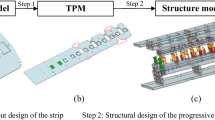Abstract
Over the last few decades, sheet metal parts have had a number of applications in the industry. The most important and most used type of the dies to production these parts is progressive dies. Computer-aided design of these dies consists of a considerable number of sections. The two most important types of these sections are nesting and piloting. Finding the best nesting plays an important role in the final cost of production and for an accurate strip positioning, the appropriate piloting system is required. In this paper, a new method for curve recognition by dividing part’s element into component points is presented for finding the best nesting and piloting state. Curve recognition data and the algorithms for finding the best nesting and piloting system were obtained just by using algebraic equations. This method leads to a decrease in the time of design. The best nesting for all parts that includes line and circular arc will be obtained with the high precision. The semi-direct and indirect pilot hole centers and its diameter will be obtained by defining four matrixes. This system is written in visual basic programming language in the SOLIDWORKS 2010 software. Finally, to compare the system’s results to similar system, the nesting and piloting systems for the number of samples are analyzed.
Similar content being viewed by others
References
Schaffer G (1971) Computer design of progressive dies. Am Mach 22:73–75
Fogg B, Jaimeson B (1975) The influencing factors in optimizing press tool die layouts and a solution using computer aids. CIRP Ann 24:429–434
Shibata Y, Kunitomo Y (1981) Sheet metal CAD/CAM [computer-aided-design/computer-aided-manufacture] system. Bull Jpn Soc Precis Eng 15:219–224
Nakahara S, Kojima T, Tamura S, Funimo A, Choichiro S and Mukumuru T (1978) Computer progressive die design. Proceedings of 19th MTDR conference 171–6
Choi J, Kim B, Cho H, Kim C, Kim J (1997) An automated die design system for blanking or piercing of stator and rotor parts. J Korean Soc Precis Eng 1:22–23
Choi JC, Kim BM, Cho HY, Kim C (1998) A compact and practical CAD system for blanking or piercing of irregular-shaped sheet metal products and stator and rotor parts. Int J Mach Tools Manuf 38:931–963
Choi CJ, Kim MB, Cho YH, Kim C, Kim HJ (1998) An integrated CAD system for the blanking of irregular-shaped sheet metal products. J Mater Process Technol 83:84–97
Choi J, Kim B, Kim C, Kim J (1997) An automated process planning system for blanking and piercing of stator and rotor parts and irregular shaped sheet metal products. J Korean Soc Precis Eng 1:46–53
Choi J, Kim C, Yoon J (2000) An automated CAD system for progressive working of irregular shaped metal products and lead frame for semiconductors. Int J Adv Manuf Technol 16:624–634
Nye T (2001) Optimal nesting of irregular convex blanks in strips via an exact algorithm. Int J Mach Tools Manuf 41:991–1002
Barzegari M, Arezoo B (1998) Computer aided progressive die design, fourth production and manufacturing engineering conference. Amirkabir University of Technology, Tehran
Lee S-B, Kim D-H, Kim B-M (2002) Development of optimal layout design system in multihole blanking process. J Mater Process Technol 130:2–8
Ghatrehnaby M, Arezoo B (2009) A fully automated nesting and piloting system for progressive dies. J Mater Process Technol 209:525–535
Ghatrehnaby M, Arezoo B (2010) Automatic piloting in progressive dies using medial axis transform. Appl Math Model 34:2981–2997
Kim J, Kim C, Chang Y (2006) Development of a process sequence determination technique by fuzzy set theory for an electric product with piercing and bending operation. Int J Adv Manuf Technol 31:450–464
Farsi M, Arezoo B (2009) Development of a new method to determine bending sequence in progressive dies. Int J Adv Manuf Technol 43:52–60
Giannakakis T, Vosniakos G (2008) Sheet metal cutting and piercing operations planning and tools configuration by an expert system. Int J Adv Manuf Technol 36:658–670
Moghaddam M, Soleymani M and Farsi M (2013) Sequence planning for stamping operations in progressive dies. J Intell Manuf 1–11
Jia Z-X, Li H-L, Zhang X-C, Li J-Q, Chen B-J (2011) Computer-aided structural design of punches and dies for progressive die based on functional component. Int J Adv Manuf Technol 54:837–852
Author information
Authors and Affiliations
Corresponding author
Additional information
The authors experience and observations in “progressive dies for Iran khodro authomotive company and other Iranian companies” Tehran, Iran.
Rights and permissions
About this article
Cite this article
Moghaddam, M.J., Farsi, M.A. & Anoushe, M. Development of a new method to automatic nesting and piloting system design for progressive die. Int J Adv Manuf Technol 77, 1557–1569 (2015). https://doi.org/10.1007/s00170-014-6542-8
Received:
Accepted:
Published:
Issue Date:
DOI: https://doi.org/10.1007/s00170-014-6542-8




